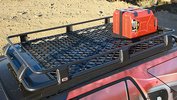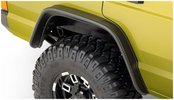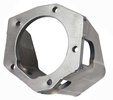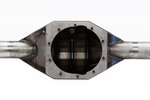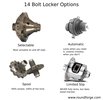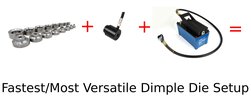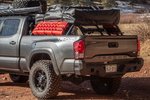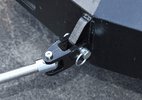The Best Camp Kitchen: How to Choose It
There are many terrible "camp kitchens" that we make do with, like picnic tables and tailgates. These are usually not convenient, efficient, or ergonomic for cooking operations and you may find yourself having an aching back, cleaning up spills from your auto's upholstery, or just wishing for a restaurant to relieve you of your cooking duties. Here's why jerry-rigged camp kitchens don't work:
The Picnic Table Slouch
Most of the time you’re not going to find a picnic table when you’re wheeling, and when you do, they are dirty or wet or rotting. Conventional kitchen counter height are 36" and picnic tables are way less than that. This means that you will adopt a Quasimodo hunch while food prepping, then pray that your camp mattress will heal your overworked back muscles. No thanks. If you’re even more unlucky, the previous camper will have left food or dripped food goo on the table.
The It-Looks-Like-It-Would-Work Cooler
Coolers are elevated off the ground and they have a relatively flat
working surface, but those are the only redeeming qualities! We have
camped in a Jeep with only a cooler for a "kitchen" thinking that it's top would provide a great work surface, and it stinks!
Their
height, of course, is all wrong for food prep and cooking, whether on the ground or on a table. It doesn’t help that
you’ll always need something from inside the cooler unless you're a superb planner.
One more thing:
lots of today’s coolers have bumpy tops with ridges and cupholders, plus
the edges of the top are severely chamfered. This makes it impossible
to have a reasonably-sized working space for holding spices or cutting boards.
Trying to chop an onion with a cutting board on one of these is a pain unless you enjoy having the plastic cutting board slip off the plastic cooler.
The Meat-Juice Absorbing Tailgate
Fold-out tailgates, like on pickup trucks, provide a flattish area
for cooking. The height is usually a good working height unless your rig
has lots of lift. But truck tailgates still don’t provide a nice even
surface for cooking. The bedliner usually has ridges that will make
things sit unevenly.
SUV tailgates, like on Toyota Land Cruisers and Chevy Suburbans, are usually flatter and more even, but also carpeted. Most of us don’t want to be spilling mustard and beer on our tailgate. Whether you have a carpeted or bare tailgate we can guarantee that you don't want to accidentally drain bloody steak juice on your tailgate - it'll get on the outside and the inside. Lastly, you’ll always need something from inside your rig while you’re cooking. Your cooking setup will be directly in the way.
The One-Trick Pony Folding Table
Okay, there are some folding tables that are okay. But they only do one thing - make a flat space. That's great for a huge family picnic, but it doesn't offer any improvements to your cooking experience. A folding table has no sink, isn’t really optimally sized, and is often way heavier and bulkier than what you need.
What Makes a Good Camp Kitchen?
After having several camp cooking accidents and spills, suffering through balancing bottles on pickup tailgates, prepping burgers on coolers, and fighting ants off picnic tables, we decided the best thing you can do is bring your own camp kitchen with a sink. You’ll have a dedicated place to prep three meals a day that is clean, organized, and easy to use. When you’re done with meals, you can wash dishes and utensils fairly easily. We’ll take a quick look at a few things that camp kitchens such as:
- Stove placement
- Counter height
- Work area size
- Sinks
- Organization
- Wind protection
- Ease of assembly
- Adjustability of legs
- Folded size
- Weight
Counter Height
Workspace height is really important. We find activities like chopping vegetables or making sandwiches are slower or uncomfortable when working at a picnic table or fold-out camp table. Taller folk will have a slight uncomfortable bend in their back standing at a table. When sitting at the table, your elbows get in the way and slow you down. That’s why kitchen counters are taller than kitchen tables!
If you try to chop vegetables or make sandwiches on a cooler, on the hood of your rig, or on a tailgate, it’s just plain frustrating because you’ll usually be working at a weird height on an unstable surface.
The standard height for kitchen counters is 36”. We’ve also read that the optimum counter height is 2-3” below the user’s elbows. Most camp kitchens have a height that is elevated above a standard table, but still below a kitchen counter. This is fine, because longer camp kitchen legs means more material, which means that the camp kitchen will weigh more and one of features we really want is a light weight.
So, our optimum counter height that we look for is 32-36”.
Stove Placement
From the counter to the top of the stove grate, we like to see a difference of 0-2”. This is pretty normal for a standard kitchen. With the many different stoves and camp kitchens available, it’s hard to determine how your particular stove will setup in a particular camp kitchen. A typical propane stove is about 3” from bottom to grate and a typical white gas stove is probably 4” from bottom to grate. For us, this means that ideally, the kitchen will have a recessed area or lower table to place the stove. We like this arrangement because it keeps the countertop, stove, pots, and pans at the same relative height to each other. This should make cooking more efficient and safer.
A stove should go on a fire-resistant grate or table made of metal. Most stoves shouldn’t get hot enough to burn whatever is under them, but this is a basic safety feature that keeps you from burning down the forest by accident.
Some stove surfaces are simply a wire grid with 2-3” spacing. This keeps the stove surface very lightweight, but some stoves have feet and protrusions that make them sit awkwardly on the stove surface. If you buy a camp kitchen with one of these wire grid surfaces, make sure you check that your stove sits without wobbling. It you have a problem you can zip-tie a large rectangle of thin metal to the grid to make a nice flat table for your stove.
Lastly, we like the fuel source for the stove to be secure and out of the way. Some stoves use a small propane canister that hangs of the stove. With some camp kitchens, this canister will be hanging in the air. While the manufacturers often show this in product images, we think it’s better to secure this part of the stove to the camp kitchen with a hose clamp, velcro strap, or zip-tie.
Work Area
Some camp kitchens still have small work areas and make the stove the central feature. We think this is crazy because having a large counter is useful for chopping fruits and veggies, seasoning, washing dishes, making sandwiches, pouring coffee, making cereal, opening cans, and tons of other stuff. We don’t want a stove in the middle of that work area! Most work areas are 20” deep and we like a length of around 30”. Again, this is a good compromise on weight and size.
Work areas would ideally be made of plastic or stainless steel. This is not always the case with cheaper camp kitchens though where we see countertops made of wood composites like water-resistant MDF. This is fine if you’re careful with your kitchen: Don’t let it stay soaking wet from dishes, don’t let it be in the rain constantly. The tops of these MDF countertops won’t leach rain, but the corners will, so be most vigilant about keeping corners dry.
Camp Kitchen Sink
Camp kitchen sinks, how do we love thee! Seriously, a camp kitchen sink can transform your camp cooking from frustrating to blissful. There are two types of camp kitchen sink: fabric and plastic tubs. Fabric? Sounds terrible, right? It’s just heavy duty waterproof nylon sewn into a box shape that you can fill with water. Fabric sinks probably cut the weight of your kitchen by a couple of pounds and fold up in a flat shape. The best fabric sinks can have considerably higher volume than a plastic sink, as well.
Let’s compare that to a plastic sink. A plastic camp kitchen sink is bulky and will typically hold less water. The depth of the sink is one of the determining factors in how compactly your camp kitchen will fold up. That said, a plastic sink will be more durable, and won’t be easily damaged by hot pans or sharp knives. One huge thing we like is that you can dry it out. We doubt it’ll dry overnight from a dinnertime washing, and most of us will need it again for breakfast in the morning anyway. This means you’re going to be packing up a wet sink that could get smelly if you need to pack up and hit the trail early.
Some sinks come with a convenient drain. This makes emptying it a lot easier - the alternative is to lift up your sink and carry to a dump spot. Water weighs about 8 lbs. per gallon, so even a small sink can be a little unwieldy. If a sink holds 4 gallons of water and has no, be mindful of how much you fill it up! make sure that you aren’t draining your sink where you shouldn’t. Lots of camping areas don’t want you dumping gross wash water wherever. Some people deal with this by draining the sink directly into a jug that can be dumped in an appropriate place. Don’t dump near water sources - stay at least 50 yards away from streams, ponds, and rivers.
Organization
Organization is important in a camp kitchen since you have so little space. You should be asking yourself, “Where will I put…”
- towels and dishcloths
- paper towels
- spices and condiments
- spatulas, spoons, and other cooking implements
- cutting boards
- pots and pans
- plastic and foil wrap
- garbage
- a lantern or other light source
It makes things so much easier when everything has its own place. Some camp kitchens have built-ins to handle the above: hooks, towel racks, shelves, and space racks. We’ve found that lighter camp kitchens have trouble storing heavy items like dutch ovens on their shelves. Again, this is a trade-off between a lightweight camp kitchen and it’s abilities. A really well-designed camp kitchen will have a windscreen that incorporates some of the above which effectively expands some of your working area.
Wind Protection
We like camp kitchens that have windscreens. A windscreen makes many things much easier, especially if it’s well-designed. On uneven ground, you can situate your kitchen so that all your rolling, round items like eggs, onions, and oranges will roll towards the windscreen instead of on to the ground. A windscreen will protect your food from pollen and dust. And one thing we really appreciate: it’ll stop chip bags and food wrappers from flapping in the wind. Even if it’s secure, we’re always unnerved by deli meat wrappers being whipped by the wind. It always seems like our sliced turkey is going to take flight and splat into the dirt. With a windscreen, these panic attacks are a thing of the past! Finally, a really great windscreen will hold things on it like spice racks and utensil hooks. The extra organization will change how easy it is to cook while camp.
Ease of Setup
When you buy your camp kitchen you need to test it before you use it, for a few reasons. First, they are rarely packaged well and can get beat up in shipping. You want to make sure that nothing is bent, that all hinges and joints work smoothly, and that accessories attach correctly. Next, whip out your stove and set it up. Make sure it fits on the designated stove space. If it’s on a wire grid, make sure that it doesn’t wobble precariously. Finally, you want to set it up for the first time in good light with low stress, not at 8:45PM after just pulling into camp.
This will also tell you how easy it is to setup. Most camp kitchens should take 5 minutes or less to set up and break down. For weekend trips or trips where you stay in one place for a long time setup time won’t matter as much, but if you’re on a two week off road trip where you camp at a different spot every night, you will dread a complicated kitchen setup with all the other camp tasks you need to complete.
Cheaper camp kitchens don’t have adjustable feet, so you need to bring something to shim the kitchen’s feet. Adjustable feet make this a lot easier, especially in rocky terrain, but they do add to the overall weight for the mechanisms inside the legs.
Portability - Weight and Folded Size
We really value light weight in our 4x4 camping gear. We have experienced fourwheeling with a heavy rig, and it’s just tougher. Stuff breaks more, it’s easier to get stuck, and it’s harder to get unstuck. So we like to use the lightest gear possible that will still give us good functionality. The perfect camp kitchen for use probably weighs at least 15 lbs. more than one that’s “good enough” (and costs a lot more money). Also a camp kitchen has to be removed and placed in your rig constantly and smaller, lighter kitchens make this easier. A reasonable weight is around 25-35 lbs. A camp kitchen of this weight will have plenty of features, aluminum construction, and will probably fold up to 40” x 20” x 6” or smaller.
Some camp kitchens fold into a suitcase shape which means they will slide easily into your 4x4. Others have protrusions to accommodate their features. Unfortunately, you probably won’t have much choice in the shape of your kitchen if your find one with really great features but a weird shape.
Last updated: June 3, 2019
